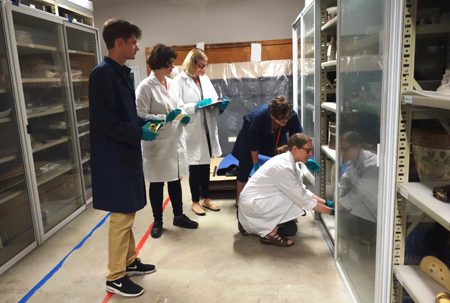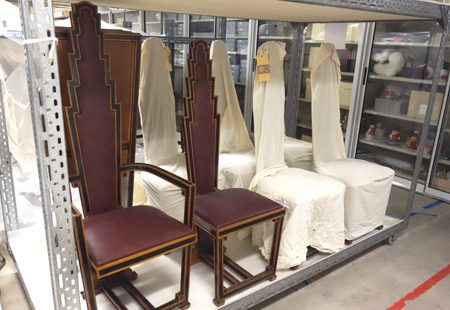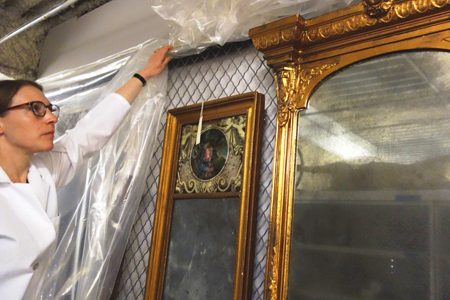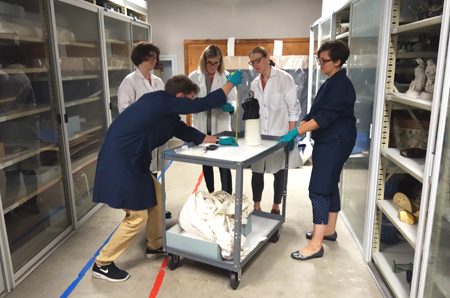Senior collection manager Britta Keller Arendt explains how the collections staff keeps track of our artifacts.
One question that Museum staff are frequently asked is “How many artifacts do you have in there?”, which is quickly followed by “How do you keep track of them all?”

Senior collection manager Britta Keller Arendt and collections technician Serena B. Washington demonstrate proper handling of heavy artifacts to collections interns. All photographs by CHM staff
The answers to these questions are complex and vary with each institution, but here at the Chicago History Museum, we have a dedicated team of collections professionals who work tirelessly to preserve the physical and intellectual integrity of the artifacts both on exhibit and in our storage facilities. Museums don’t have the space or resources to display every single artifact, so managing storage facilities is imperative to preserving collections. CHM is fortunate to be able to store a variety of artifacts—such as costumes, paintings, and decorative and industrial arts—on-site as well as at two off-site locations.
So, how does the Museum keep track of artifacts stored in so many locations? One effective way is to conduct periodic inventories of storage spaces. Ideally, most museums strive to inventory collections on a regular basis, about once every one to ten years, depending on the size and type of collection. Starting in June, we embarked on a journey to inventory the artifacts stored on the Museum’s fourth floor, known by Museum staff as the Decorative and Industrial Arts (DIA) Collection. With the assistance of an amazing crew of interns and volunteers, we were able to inventory a majority of the furniture collection in this space—not an easy task, considering just how large and delicate many of these pieces are.

Set of chairs designed by Abel Faidy in 1927 and made in the shops of Marshall Field & Company. Purchased by CHM, 1977.191.2c-j
Conducting a collections inventory can be a challenging assignment, especially at an institution like this one, which has an extensive artifact collection that’s been accumulating for nearly 150 years. However, we developed a plan and taught the interns and volunteers the importance of executing such a project. We commenced by pulling each artifact from its designated shelf, photographing and measuring each item, and then logging pertinent acquisition information onto an inventory worksheet. Approximately once a week, these worksheets would be reviewed for consistency, and all relevant information updated in the collections database, including the location of each object. On several occasions, historical provenance would be researched to ensure that acquisition-related information was correct and did not conflict with another artifact. When you have three similarly styled gilded mirrors located on the same storage rack, it’s important to verify your data!

Arendt uncovers a storage rack of mirrors that need further research.

L to R: Intern Ryan Meara takes artifact dimensions while interns Elise Cabral and Jessica Cunny record information. Arendt and Washington observe and offer advice.
While a time-consuming and demanding endeavor indeed, collections inventory is also very rewarding. Errors are corrected, mysteries are solved, and newer team members get to “discover” some truly amazing artifacts! Collections staff use opportunities such as these to mentor interns and volunteers in the intricacies of collections work, with the hopes that our students will grow to become the next generation of museum professionals. Summer may be coming to a close, but the DIA inventory project continues. New interns will assist staff and learn about this essential task in museum collections management, and more information will be added to our collections database. When asked how many artifacts the Museum has, we can say that there are approximately 100,000 three-dimensional artifacts in the collection. That’s a lot of artifacts to manage, but the collections team can do it!